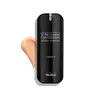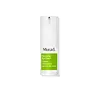What's inside
What's inside
 Key Ingredients
Key Ingredients

 Benefits
Benefits

 Concerns
Concerns

 Ingredients Side-by-side
Ingredients Side-by-side

Water
Skin ConditioningCaprylic/Capric Triglyceride
MaskingGlycerin
HumectantButylene Glycol
HumectantIsododecane
EmollientSqualane
EmollientCetearyl Alcohol
EmollientDimethicone
EmollientCetearyl Olivate
Sodium Acrylate/Sodium Acryloyldimethyl Taurate Copolymer
Emulsion StabilisingPolylactic Acid
AbrasiveCyclodextrin
AbsorbentPPG-12/Smdi Copolymer
EmollientSorbitan Olivate
EmulsifyingTitanium Dioxide
Cosmetic ColorantEclipta Prostrata Extract
Skin ConditioningPhenethyl Alcohol
MaskingMelia Azadirachta Leaf Extract
Skin ConditioningPhenoxyethanol
PreservativeCholesteryl Nonanoate
EmollientSodium Hyaluronate
HumectantTocopheryl Acetate
AntioxidantRubus Chamaemorus Seed Oil
Skin ConditioningCanola Oil
EmollientXanthan Gum
EmulsifyingPentylene Glycol
Skin ConditioningRetinal
Skin ConditioningRetinyl Retinoate
Skin ConditioningCitric Acid
BufferingAlumina
AbrasiveIsostearic Acid
CleansingLecithin
EmollientPolyglyceryl-3 Polyricinoleate
EmulsifyingPolyhydroxystearic Acid
EmulsifyingStearic Acid
CleansingCeramide AP
Skin ConditioningMoringa Oleifera Seed Oil
EmollientSodium Lauroyl Lactylate
EmulsifyingVanilla Planifolia Fruit Extract
Skin ConditioningEthylhexylglycerin
Skin ConditioningLinoleic Acid
CleansingPalmitic Acid
EmollientCeramide NP
Skin ConditioningDaucus Carota Sativa Seed Oil
EmollientDisodium EDTA
Phytosterols
Skin ConditioningLonicera Japonica Flower Extract
Skin Conditioning3-O-Ethyl Ascorbic Acid
Skin ConditioningLonicera Caprifolium Flower Extract
PerfumingSodium Polyaspartate
HumectantPhytosphingosine
Skin ConditioningParfum
MaskingCopper Palmitoyl Heptapeptide-14
Skin ConditioningHeptapeptide-15 Palmitate
Skin ConditioningCeramide EOP
Skin ConditioningCholesterol
EmollientC12-16 Alcohols
EmollientCaprylyl Glycol
EmollientCarbomer
Emulsion StabilisingHydrogenated Lecithin
EmulsifyingGlyceryl Caprylate
EmollientLactic Acid/Glycolic Acid Copolymer
Skin ConditioningPolyvinyl Alcohol
Phenylpropanol
MaskingBHT
AntioxidantLimonene
PerfumingLinalool
PerfumingCitral
PerfumingWater, Caprylic/Capric Triglyceride, Glycerin, Butylene Glycol, Isododecane, Squalane, Cetearyl Alcohol, Dimethicone, Cetearyl Olivate, Sodium Acrylate/Sodium Acryloyldimethyl Taurate Copolymer, Polylactic Acid, Cyclodextrin, PPG-12/Smdi Copolymer, Sorbitan Olivate, Titanium Dioxide, Eclipta Prostrata Extract, Phenethyl Alcohol, Melia Azadirachta Leaf Extract, Phenoxyethanol, Cholesteryl Nonanoate, Sodium Hyaluronate, Tocopheryl Acetate, Rubus Chamaemorus Seed Oil, Canola Oil, Xanthan Gum, Pentylene Glycol, Retinal, Retinyl Retinoate, Citric Acid, Alumina, Isostearic Acid, Lecithin, Polyglyceryl-3 Polyricinoleate, Polyhydroxystearic Acid, Stearic Acid, Ceramide AP, Moringa Oleifera Seed Oil, Sodium Lauroyl Lactylate, Vanilla Planifolia Fruit Extract, Ethylhexylglycerin, Linoleic Acid, Palmitic Acid, Ceramide NP, Daucus Carota Sativa Seed Oil, Disodium EDTA, Phytosterols, Lonicera Japonica Flower Extract, 3-O-Ethyl Ascorbic Acid, Lonicera Caprifolium Flower Extract, Sodium Polyaspartate, Phytosphingosine, Parfum, Copper Palmitoyl Heptapeptide-14, Heptapeptide-15 Palmitate, Ceramide EOP, Cholesterol, C12-16 Alcohols, Caprylyl Glycol, Carbomer, Hydrogenated Lecithin, Glyceryl Caprylate, Lactic Acid/Glycolic Acid Copolymer, Polyvinyl Alcohol, Phenylpropanol, BHT, Limonene, Linalool, Citral
Water
Skin ConditioningButylene Glycol
HumectantTricaprylyl Citrate
EmollientPentylene Glycol
Skin ConditioningBis-Diglyceryl Polyacyladipate-2
EmollientJojoba Esters
EmollientGlycerin
HumectantBoron Nitride
AbsorbentCaprylic/Capric/Myristic/Stearic Triglyceride
EmollientCetyl Alcohol
EmollientStearic Acid
CleansingGlyceryl Stearate
EmollientPEG-100 Stearate
Citrus Unshiu Peel Extract
MaskingMangifera Indica Seed Butter
Skin ConditioningDimethicone
EmollientCetyl Phosphate
EmulsifyingUrea
BufferingYeast Amino Acids
HumectantTrehalose
HumectantInositol
HumectantTaurine
BufferingBetaine
HumectantGlycine Soja Seed Extract
Skin ConditioningIris Florentina Root Extract
MaskingDioscorea Villosa Root Extract
Skin ConditioningGlycine Soja Sterols
EmollientTrifolium Pratense Flower Extract
AstringentPalmitoyl Oligopeptide
CleansingPalmitoyl Tetrapeptide-7
Skin ConditioningRetinol
Skin ConditioningSodium Hyaluronate
HumectantSerenoa Serrulata Fruit Extract
Skin ConditioningOenothera Biennis Oil
EmollientTocopherol
AntioxidantAscorbyl Palmitate
AntioxidantBorago Officinalis Seed Oil
EmollientDipeptide-2
Skin ConditioningHesperidin Methyl Chalcone
AntioxidantCaprylic/Capric Triglyceride
MaskingSodium PCA
HumectantPanthenol
Skin ConditioningOleyl Alcohol
EmollientSteareth-20
CleansingLecithin
EmollientCarbomer
Emulsion StabilisingPolysorbate 20
EmulsifyingSodium Potassium Aluminum Silicate
Aminomethyl Propanol
BufferingDisodium EDTA
Silica
AbrasivePhenoxyethanol
PreservativeCaprylyl Glycol
EmollientChlorphenesin
AntimicrobialCI 77891
Cosmetic ColorantWater, Butylene Glycol, Tricaprylyl Citrate, Pentylene Glycol, Bis-Diglyceryl Polyacyladipate-2, Jojoba Esters, Glycerin, Boron Nitride, Caprylic/Capric/Myristic/Stearic Triglyceride, Cetyl Alcohol, Stearic Acid, Glyceryl Stearate, PEG-100 Stearate, Citrus Unshiu Peel Extract, Mangifera Indica Seed Butter, Dimethicone, Cetyl Phosphate, Urea, Yeast Amino Acids, Trehalose, Inositol, Taurine, Betaine, Glycine Soja Seed Extract, Iris Florentina Root Extract, Dioscorea Villosa Root Extract, Glycine Soja Sterols, Trifolium Pratense Flower Extract, Palmitoyl Oligopeptide, Palmitoyl Tetrapeptide-7, Retinol, Sodium Hyaluronate, Serenoa Serrulata Fruit Extract, Oenothera Biennis Oil, Tocopherol, Ascorbyl Palmitate, Borago Officinalis Seed Oil, Dipeptide-2, Hesperidin Methyl Chalcone, Caprylic/Capric Triglyceride, Sodium PCA, Panthenol, Oleyl Alcohol, Steareth-20, Lecithin, Carbomer, Polysorbate 20, Sodium Potassium Aluminum Silicate, Aminomethyl Propanol, Disodium EDTA, Silica, Phenoxyethanol, Caprylyl Glycol, Chlorphenesin, CI 77891
 Reviews
Reviews

Ingredients Explained
These ingredients are found in both products.
Ingredients higher up in an ingredient list are typically present in a larger amount.
Butylene Glycol (or BG) is used within cosmetic products for a few different reasons:
Overall, Butylene Glycol is a safe and well-rounded ingredient that works well with other ingredients.
Though this ingredient works well with most skin types, some people with sensitive skin may experience a reaction such as allergic rashes, closed comedones, or itchiness.
Learn more about Butylene GlycolThis ingredient is an emollient, solvent, and texture enhancer. It is considered a skin-softener by helping the skin prevent moisture loss.
It helps thicken a product's formula and makes it easier to spread by dissolving clumping compounds.
Caprylic Triglyceride is made by combining glycerin with coconut oil, forming a clear liquid.
While there is an assumption Caprylic Triglyceride can clog pores due to it being derived from coconut oil, there is no research supporting this.
Learn more about Caprylic/Capric TriglycerideCaprylyl Glycol is a humectant and emollient, meaning it attracts and preserves moisture.
It is a common ingredient in many products, especially those designed to hydrate skin. The primary benefits are retaining moisture, skin softening, and promoting a healthy skin barrier.
Though Caprylyl Glycol is an alcohol derived from fatty acids, it is not the kind that can dry out skin.
This ingredient is also used as a preservative to extend the life of products. It has slight antimicrobial properties.
Learn more about Caprylyl GlycolCarbomer is a polymer of acrylic acid. Its main role is to create a gel consistency.
A high amount of carbomer can cause pilling or balling up of products. Don't worry, most products contain 1% or less of carbomer.
Dimethicone is a type of synthetic silicone created from natural materials such as quartz.
What it does:
Dimethicone comes in different viscosities:
Depending on the viscosity, dimethicone has different properties.
Ingredients lists don't always show which type is used, so we recommend reaching out to the brand if you have questions about the viscosity.
This ingredient is unlikely to cause irritation because it does not get absorbed into skin. However, people with silicone allergies should be careful about using this ingredient.
Note: Dimethicone may contribute to pilling. This is because it is not oil or water soluble, so pilling may occur when layered with products. When mixed with heavy oils in a formula, the outcome is also quite greasy.
Learn more about DimethiconeDisodium EDTA plays a role in making products more stable by aiding other preservatives.
It is a chelating agent, meaning it neutralizes metal ions that may be found in a product.
Disodium EDTA is a salt of edetic acid and is found to be safe in cosmetic ingredients.
Learn more about Disodium EDTAGlycerin is already naturally found in your skin. It helps moisturize and protect your skin.
A study from 2016 found glycerin to be more effective as a humectant than AHAs and hyaluronic acid.
As a humectant, it helps the skin stay hydrated by pulling moisture to your skin. The low molecular weight of glycerin allows it to pull moisture into the deeper layers of your skin.
Hydrated skin improves your skin barrier; Your skin barrier helps protect against irritants and bacteria.
Glycerin has also been found to have antimicrobial and antiviral properties. Due to these properties, glycerin is often used in wound and burn treatments.
In cosmetics, glycerin is usually derived from plants such as soybean or palm. However, it can also be sourced from animals, such as tallow or animal fat.
This ingredient is organic, colorless, odorless, and non-toxic.
Glycerin is the name for this ingredient in American English. British English uses Glycerol/Glycerine.
Learn more about GlycerinLecithin is a term for a group of substances found in the cell membranes of plants, animals, and humans. They are made up of mixture of phospholipids.
This ingredient has emollient and emulsifying properties.
As an emollient, lecithen helps soften the skin and creates a barrier to keep moisture in.
As an emulsifier, it also helps prevent water and oil ingredients from separating. Lecithin can also help ingredients be better absorbed by the skin.
This is because the phospholipids in lecithin produce liposomes. Liposomes help other ingredients get through the skin barrier.
Depending on the source of this ingredient, lecithin may not be fungal acne safe. This is because some sources of lecithin come from soybean oil, which may feed the malassezia yeast that feeds fungal acne.
We recommend reaching out to the brand you are purchasing from to inquire about the source of their lecithin.
Some other names for this ingredient include soy lecithin and deoiled soy lecithin.
Learn more about LecithinPentylene glycol is typically used within a product to thicken it. It also adds a smooth, soft, and moisturizing feel to the product. It is naturally found in plants such as sugar beets.
The hydrophilic trait of Pentylene Glycol makes it a humectant. As a humectant, Pentylene Glycol helps draw moisture from the air to your skin. This can help keep your skin hydrated.
This property also makes Pentylene Glycol a great texture enhancer. It can also help thicken or stabilize a product.
Pentylene Glycol also acts as a mild preservative and helps to keep a product microbe-free.
Some people may experience mild eye and skin irritation from Pentylene Glycol. We always recommend speaking with a professional about using this ingredient in your routine.
Pentylene Glycol has a low molecular weight and is part of the 1,2-glycol family.
Learn more about Pentylene GlycolPhenoxyethanol is a preservative that has germicide, antimicrobial, and aromatic properties. Studies show that phenoxyethanol can prevent microbial growth. By itself, it has a scent that is similar to that of a rose.
It's often used in formulations along with Caprylyl Glycol to preserve the shelf life of products.
Sodium Hyaluronate is hyaluronic acid's salt form. It is commonly derived from the sodium salt of hyaluronic acid.
Like hyaluronic acid, it is great at holding water and acts as a humectant. This makes it a great skin hydrating ingredient.
Sodium Hyaluronate is naturally occurring in our bodies and is mostly found in eye fluid and joints.
These are some other common types of Hyaluronic Acid:
Learn more about Sodium HyaluronateStearic Acid is a fatty acid. It is an emollient, emulsifier, and texture enhancer.
As an emollient, stearic acid helps soften skin. It aids the skin's protective barrier by preventing water loss. It also provides a gentle cleansing effect without stripping away natural oils.
Stearic acid may also be used to enhance the texture of products. It can add volume and stabilize ingredients such as water and oil. This can help water and oil ingredients from separating.
Sources of stearic acid include animal or vegetable fats/oils such as coconut or shea. It can be naturally found in butter, cocoa butter, shea butter, vegetable fats, and animal tallow.
This ingredient may not be Malassezia folliculitis, or fungal-acne safe.
Learn more about Stearic AcidWater. It's the most common cosmetic ingredient of all. You'll usually see it at the top of ingredient lists, meaning that it makes up the largest part of the product.
So why is it so popular? Water most often acts as a solvent - this means that it helps dissolve other ingredients into the formulation.
You'll also recognize water as that liquid we all need to stay alive. If you see this, drink a glass of water. Stay hydrated!
Learn more about Water